© 2006-2011 Bob Hackett and
Sander Kingsepp
Revision 1
SENSUIKAN!
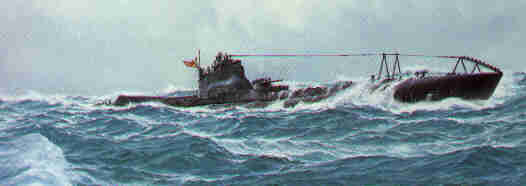
Midget Submarines Based at Okinawa and the Ryukyu
Islands
1944-1945
1609:
Japan invades the Ryukyu Kingdom. The Ryukyu Islands (Nansei Shoto)
stretch across the East China Sea from SW Kyushu to 75 miles from Formosa (now
Taiwan). Okinawa is the largest island in the chain. In 1879, the Meiji
government annexes the Ryukyus, as Okinawa Prefecture.
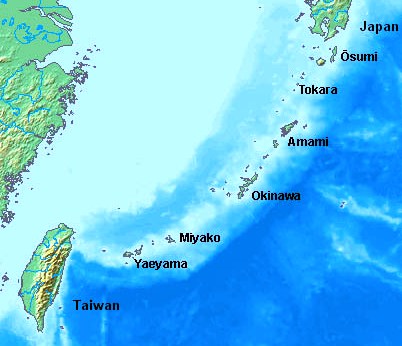 Ryukyus map showing Okinawa and Amami Oshima
Late August 1944:
Ryukyus map showing Okinawa and Amami Oshima
Late August 1944:
Nine Type C midget
submarines, including HA-60 thru HA-68, are towed by small sailing vessels from
Kurahashi Jima, Japan (Base "P") to Naha, Okinawa. Lt Tsuruta Tsuto is CO of the
1st "Dragon” Squadron.
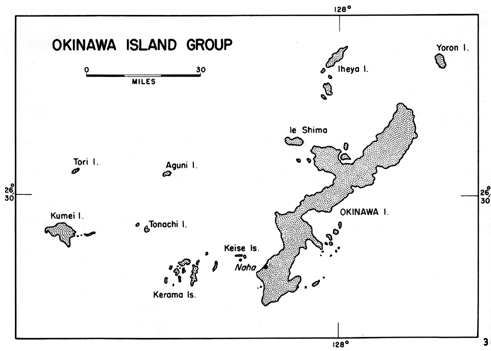 Okinawa
(U.S. Army)
September 1944:
Okinawa
(U.S. Army)
September 1944:
Okinawa. The 3210th Construction Battalion from
Sasebo starts construction of a midget submarine base at Unten Bay's harbor on
the island's northern coast. The base is shared by “Shinyo”(Ocean Shaker)
explosive motor torpedo boats of the 27th Squadron.
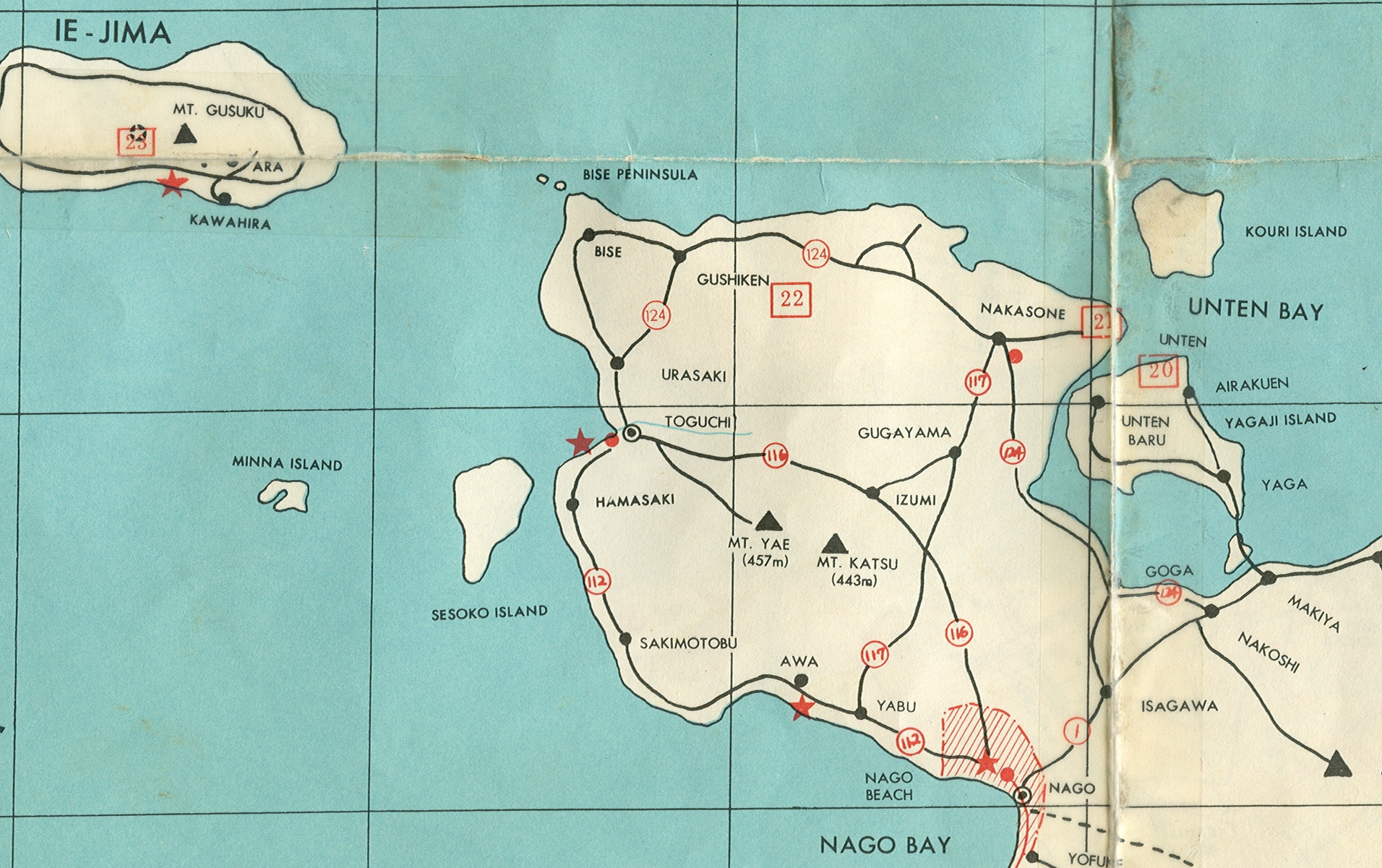 Unten Bay, Okinawa
(CalTex)
10 October 1944:
Unten Bay, Okinawa
(CalTex)
10 October 1944:
Vice Admiral (later Admiral) Marc A. Mitscher's
(USNA '10) (former CO of HORNET, CV-8) Task Force 38 launches the first strikes
on Okinawa for the pre-invasion landings on Leyte, Philippines. TF 38's aircraft
strike the Okinawa area and the Unten base that is about 80 percent complete. A
Grumman F-6F "Hellcat" fighter-bomber from BUNKER HILL (CV-17) drops a bomb
between two midget submarines moored side-by-side. Midget submarines HA-61,
HA-62, HA-63, HA-65, HA-66 and HA-68 are lost in the air attacks.
The midget submarines' depot ship, Captain Oyama Toyojiro’s (47) JINGEI,
torpedoed the previous month by LtCdr Frederick A. Gunn’s (USNA '34) USS
SCABBARDFISH (SS-397) and beached in shallow water, is attacked by aircraft from
TG 38.2's HANCOCK (CV-19) and sunk at 26-39N, 127-52E. [1]
28 January 1945:
Kurahashi Jima. Two three-strong groups of Type D (“Koryu”)
midget submarines depart for Unten under their own power accompanied by
small steamers FUYO and FUJI MARUs. The groups include midget submarines HA-204,
HA-207 and HA-208. Enroute, they make stopovers at Hikari, Tokuyama, Hakata,
Hirado and Sasebo. One midget submarine collides with FUJI MARU and damages her
torpedo tube doors; another midget submarine damages her main ballast tank in
heavy seas. The second detachment is known as the Hanada detachment, after its
CO, Lt (j.g.) Hanada Kenji (71). [2]
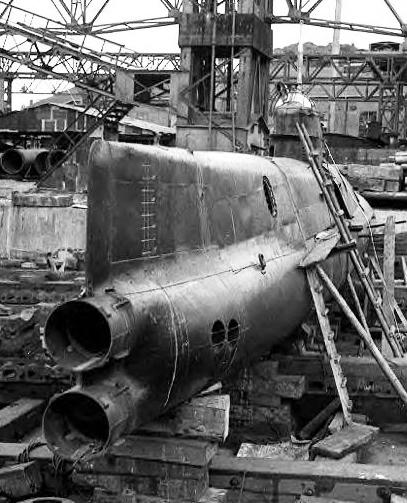 Type D Koryu at Yokosuka, postwar
(National Archives)
February 1945:
Type D Koryu at Yokosuka, postwar
(National Archives)
February 1945:
Sasebo. The damaged midget submarines are repaired.
2 March 1945:
Transport T. 17 departs Kurahashi Jima, carrying Type D
midget submarines HA-209 and HA-210.
8 March 1945:
T. 17 arrives at Unten and unloads her cargo. The
midget submarines are assigned to Lt Kawashima Gen's 2nd “Dragon” Squadron.
10 March 1945:
After completion of repairs, the midget submarines and
the two steamers depart Sasebo and arrive at Unten. HA-208 is the last to
arrive. Later, FUJI MARU departs Unten for Kurahashi Jima to pick up the unit's
remaining personnel.
14 March 1945:
At 1538, USN codebreakers at Fleet Radio Unit,
Melbourne (FRUMEL), Australia intercept and decode a message from Tokyo Naval
Section that reads "1. The 4 type-“TEI" (Type D) midget submarines and the two
type-“HEI" Type C midget
submarines for assignment to Okinawa will leave Kure on Transport No. ? before
the end of March. A total strength of 18 vessels is planned and a tender will be
assigned later. 2. An additional 6 type-“TEI" midget submarines will be
dispatched to Okinawa before the 20th April."
21 March 1945:
Convoy KANA-101 consisting of cargo ships KACHOSAN MARU
and YAMATO MARU No. 19 depart Kagoshima escorted by kaibokan CD-29, subchaser
CH-58 and auxiliary minesweeper TAIAN MARU. The cargo ships are probably each
towing a midget submarine.
22 March 1945:
At 2200, arrives at Kuji Wan (Bay), Amami Oshima.
23 March 1945:
At 0530, departs Kuji Wan. At 1030, the CO of CD-29
orders the convoy away from its intended destination of Okinawa and directs it
to head to the China coast.
Off Sotsukozaki, Amami Oshima. At 1615, aircraft from Vice Admiral
Mitscher's Task Force 58 attack the convoy. KACHOSAN MARU is bombed and sinks at
1628. CD-29 and CH-58 are also damaged. TF 58's aircrews also claim sinking one
midget submarine and damaging another,
Unten Bay, Okinawa. F-6F-5P "Hellcat" photo-recon pilots from USS ESSEX
(CV-9) ferret out Unten's midget submarines in cleverly concealed pens. Aircraft
from ESSEX's Air Group 83 attack and destroy the installations. Lt Watanabe
Yoshiyuki's Type C midget submarine is sunk. [3]
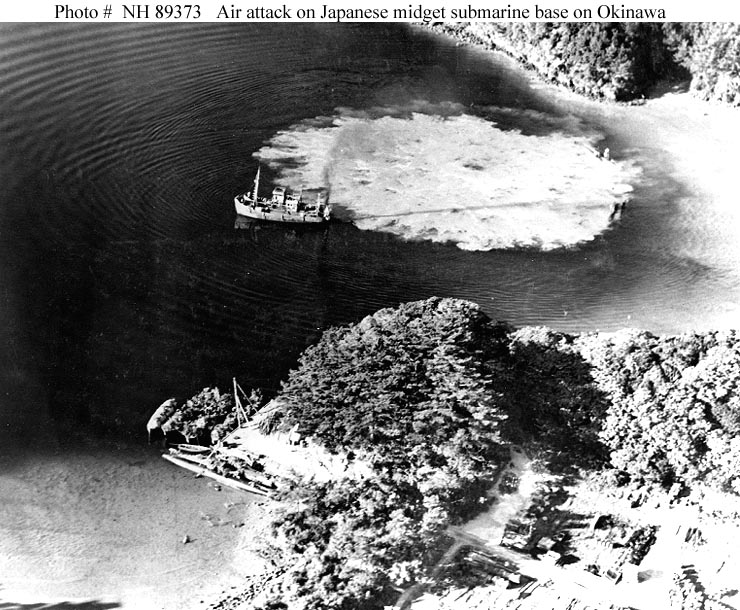 Unten Bay's Midget Submarines under Attack
(Official U.S. Navy Photograph, Naval Historical
Center)
March 1945:
Unten Bay's Midget Submarines under Attack
(Official U.S. Navy Photograph, Naval Historical
Center)
March 1945:
Kurahashi Jima. FUJI MARU departs on her second voyage to
Unten.
25 March 1945:
Off Torishima. At 1350 (JST), FUJI MARU is sunk
enroute to Unten by LtCdr (later Captain/MOH) George L. Street's (USNA '37) USS
TIRANTE (SS-420) at 31-09N, 130-31E. Forty-five of the base's technical
personnel perish in the attack.
Off Keise Shima. Early in the morning, a recce plane reports sighting six
American battleships, six cruisers and 20 destroyers. The CO of the Okinawa Area
Auxiliary Base Unit, Rear Admiral (Vice Admiral, posthumously) Ota Minoru orders
the Unten midget submarine unit to intercept and attack the enemy force.
Kerama Retto. That same day, Rear Admiral (Vice Admiral-Ret) Morton L.
Deyo’s (USNA '11) Task Force 54’s battleships, cruisers and destroyers bombard
Kerama and the SE coast of Okinawa.
At 1432, USN codebreakers at Fleet Radio Unit, Melbourne (FRUMEL),
Australia intercept and decode a message from the Sasebo Naval District that
reads “1. Midget submarines No. 201, No. 202 and No. 203 and the torpedo boats
moving up to Okinawa will proceed to (Amami) O-Shima and come under the
temporary command of (Amami) O-Shima Defense Unit. 2. All convoys in the Oklnawa
Area will make immediately for the nearest harbor in Kyushu."
Yokohama. Also that day, Headquarters, Combined Fleet housed at Keio
University, issues an alert for Operation "Ten-Go". That night, between 2200 and
2400, the 1st squadron, comprising Ensign Kawamoto Shichiro's Type C midget
submarine HA-67, Lt Okawa Nobuyoshi's Type D HA-209 and Lt ( j.g.) Karashi
Sadanao's Type D HA-210, departs Unten in one-hour intervals.
26 March 1945:
Kerama Retto. The American 77th Infantry Infantry
Division lands to capture advance bases and anchorages for the invasion of the
main island of Okinawa. From 0940-1040, cruisers USS WICHITA (CA-45), ST LOUIS
(CA-49) and BILOXI (CL-80) sight and avoid torpedo tracks that may have come
from midget submarines.
At about 1835, that same day, Ensign Kawamoto's midget submarine HA-67
torpedoes USS HALLIGAN (DD-584) at 26-10N, 127-30E. HALLIGAN's forward magazines
explode. 162 of her crew are lost. Kawamoto reports two hits on an enemy
"battleship". An IJA artillery lookout station on Okinawa confirms his hits.
HALLIGAN drifts for 12 miles then piles up on a reef off Tokashiki Island. [4]
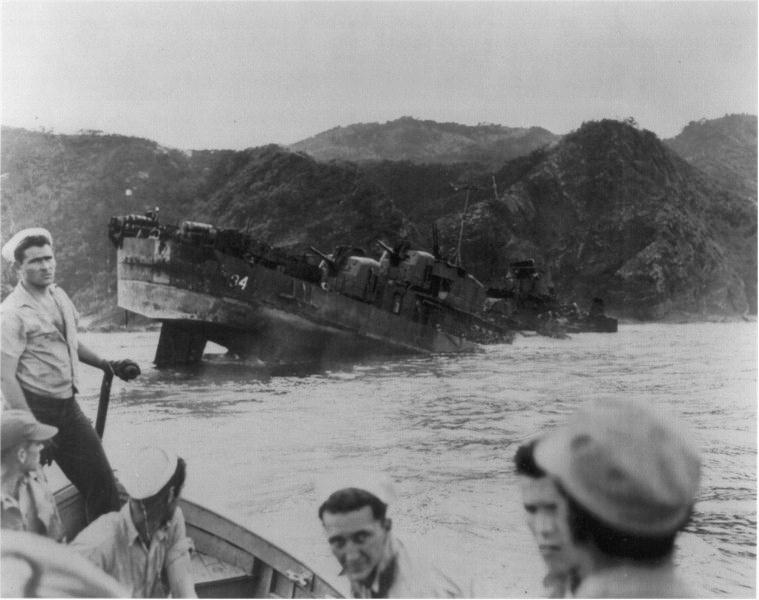 Wrecked USS HALLIGAN (DD-584)
(NavSource Naval History )
Okawa's HA-209 and Karashi's HA-210 go MIA. That evening, between 1756
and 2400, the CO of the 2nd Squadron, Lt Kawashima Gen's Type C midget submarine
HA-60, WO Sato Takaaki's HA-64 and Type D midget submarine HA-208 depart Unten
to participate in operation “Ten-Go”. HA-208 is forced to return to base soon
thereafter because of a machinery breakdown.
Yokohama. Headquarters, Combined Fleet activates Operation Ten-Go that
calls for all air and sea units to engage in a "final decisive battle".
27 March 1945:
Wrecked USS HALLIGAN (DD-584)
(NavSource Naval History )
Okawa's HA-209 and Karashi's HA-210 go MIA. That evening, between 1756
and 2400, the CO of the 2nd Squadron, Lt Kawashima Gen's Type C midget submarine
HA-60, WO Sato Takaaki's HA-64 and Type D midget submarine HA-208 depart Unten
to participate in operation “Ten-Go”. HA-208 is forced to return to base soon
thereafter because of a machinery breakdown.
Yokohama. Headquarters, Combined Fleet activates Operation Ten-Go that
calls for all air and sea units to engage in a "final decisive battle".
27 March 1945:
Early in the morning, while recharging her batteries,
Lt (j.g.) Sakai Kazuo's HA-208 is sunk in an air attack.
Lt Kawashima's midget submarine HA-60 attacks Task Group 54. 3 west of
Cape Zampa Misaki (Bolo Point). At 0932, lookouts aboard USS WICHITA (CA-45)
spot a periscope to starboard. WICHITA makes an emergency turn to starboard and
evades a torpedo. USS ST. LOUIS (CA-49) also reports sighting torpedo tracks.
Neither cruiser is damaged. Kawashima's HA-60 evades and escapes counter-attack.
Around 1400, WO Sato's midget submarine HA-64 attempts to attack
minelayer USS SUCCESS (AM-310) 6 nms W of Zampa Misaki, but misses with both
torpedoes. Nevertheless, WO Sato is credited with seriously damaging a cruiser.
28 March 1945:
Lt Kawashima's HA-60 and WO Sato's HA-64 return to
Unten. On that day, the CO of Sasebo Naval Station sends a signal to the Unten
unit with congratulations on its successful attacks.
29 March 1945:
Unten. By this date, as a result of bombing, the
number of serviceable midget submarines has been reduced to three.
30 March 1945:
After sundown, Ensign Kawamoto's midget submarine
HA-67 sorties from Unten, but has to return because of a machinery breakdown
soon thereafter.
31 March 1945:
Unten. Lt Kawashima's midget submarine HA-60 sorties
from Unten, despite having a damaged periscope. His craft is attacked by a
patrol aircraft and runs aground when taking evasive action. A serious leak
appears and the midget has to be abandoned.
In the evening, kaibokan CD-186 and subchasers CH-17, CH-49 depart Sasebo
escorting landing ship transports T. 17, T. 145 and T. 146 to Amami-O-Shima. The
transports are carrying various supplies and T. 17 is carrying two unidentified
Koryu (Type D) midget submarines. Enroute, the convoy is attacked by aircraft
and T. 145 is lost.
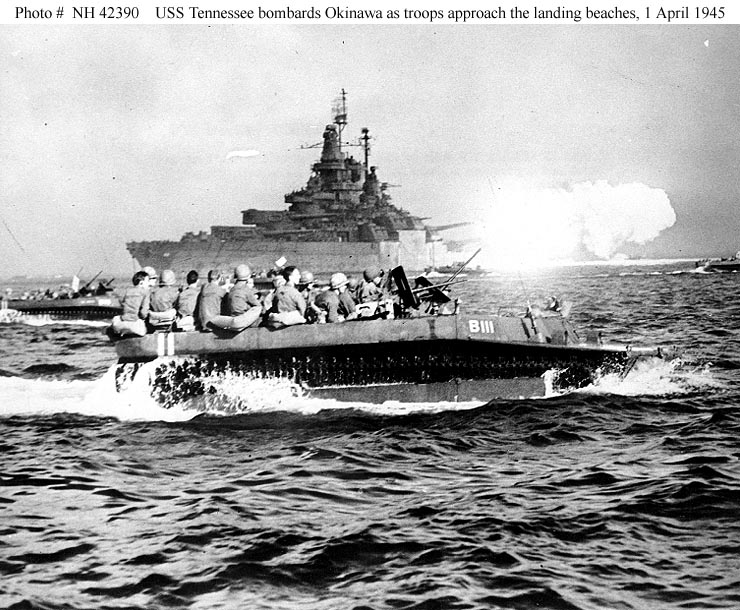 Pearl Harbor Survivor TENNESSEE (BB-43) Bombards Okinawan Landing
Beaches
(Official U.S. Navy Photograph, Naval Historical
Center)
1 April 1945: American Operation “Iceberg” – The Invasion of Okinawa:
Pearl Harbor Survivor TENNESSEE (BB-43) Bombards Okinawan Landing
Beaches
(Official U.S. Navy Photograph, Naval Historical
Center)
1 April 1945: American Operation “Iceberg” – The Invasion of Okinawa:
Vice Admiral (later Admiral) Raymond A. Spruance's (USNA '06) Fifth Fleet,
including more than 40 aircraft carriers, 18 battleships, 200 destroyers and
over 1,000 support ships surround Okinawa. Lt Gen (Gen, posthumously) Simon B.
Buckner Jr’s Tenth Army (7th, 77th, 96th Infantry, 2nd, 6th Marine divisions)
makes amphibious landings and begins the campaign to take the island from the
Imperial Army's LtGen Ushijima Mitsuro’s 32nd Army defenders.
2 April 1945:
Early in the morning the landing ship transport convoy
arrives at Amami-O-Shima. Just after T. 17 disembarks her midgets, an air attack
commences. T. 17 is hit by two bombs and sinks. CD-186 is also sunk.
5 April 1945:
WO Sato's midget submarine HA-64 and Ensign Kawamoto's
HA-67 sortie to intercept an enemy convoy sighted off Kadena Bight.
6 April 1945:
Sato's HA-64 and Kawamoto's HA-67 return to Unten after
an unsuccessful attack on an enemy destroyer at an unrecorded location. That
evening, American ground forces advance on Unten.
7 April 1945:Operation
TEN-ICHI-GO - The Attack on American Invasion Forces at Okinawa:
Vice Admiral (Admiral, posthumously) Ito Seiichi (former CO of
HARUNA) CINC, Second Fleet leads the Surface Special Attack Force’s battleship
YAMATO, DesRon 2's light cruiser YAHAGI, DesDiv 17's ISOKAZE, HAMAKAZE and
YUKIKAZE, DesDiv 21's KASUMI, HATSUSHIMO and ASASHIMO and DesDiv 41's FUYUZUKI
and SUZUTSUKI to attack the American invasion forces at Okinawa. Enroute, Ito’s
small fleet is smothered in attacks by hundreds of American aircraft from Task
Group 58. YAMATO, YAHAGI and four of the eight destroyers are sunk.
That day, Unten's shore installations and the last remaining midget
submarines, WO Sato's HA-64 and Ensign Kawamoto's HA-67 are blown up. Later,
their crews join IJN land forces.
Late May 1945:
After suffering heavy losses during the fights with
American troops, Lt Tsuruta orders the Okinawa midget submarine unit to be
officially disbanded.
July-September 1945:
Unten harbor. A Type C midget submarine, one of
the many sunk by aircraft during the Okinawa campaign, is salvaged by USS
CATCLAW (AN-60) and BARETTA (AN-41). [5]
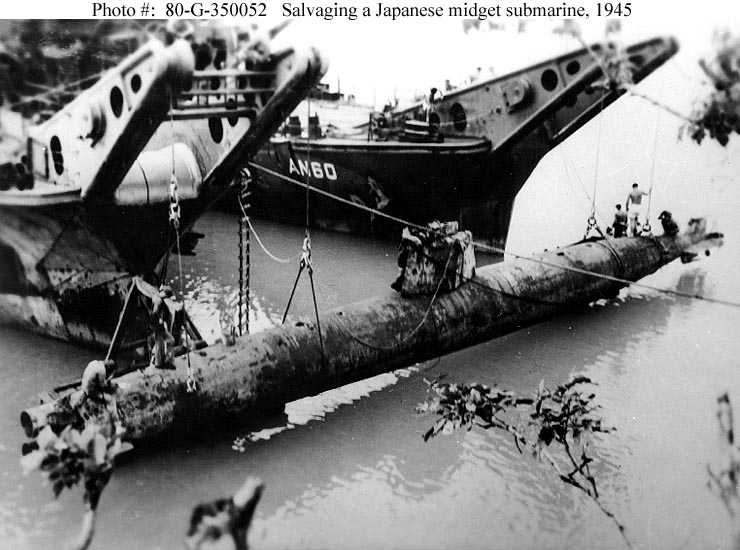
|
(Official U.S. Navy Photograph, Naval Historical
Center)
7 July 1945:
After escaping from Okinawa island in a small boat, WO
Sato (former CO of HA-64) and Chief Machinist Mate Yamada arrive at Yoron-Jima
Island, Amami Islands, 12 miles N of Okinawa.
18 August 1945:
An unidentified American submarine rescues eight
Japanese from a drifting boat, all former members of the Okinawa Midget Unit.
Authors’ Notes:
[1] On 19 Sep ’44, JINGEI was torpedoed by USS SCABBARDFISH (SS-397) 80
miles NW of Okinawa. Damaged severely forward of the bridge by the torpedoes,
JINGEI was later towed to shallow ground NE of Naha where she presented a
stationary target for HANCOCK’s planes.
[2] The IJN's redundant hull numbering can cause confusion. HA-200 series
Type D Koryu midget submarines should not be confused with identically numbered
HA-200 series Sen Taka Sho small fast submarines.
[3] Lt Watanabe's name does not appear on unit casualty lists' therefore,
it appears he survived.
[4] American sources claim gunfire support ship HALLIGAN (DD-584) struck
a mine, but the Japanese claim the destroyer was torpedoed by Ensign Kawamoto's
HA-67. Although, Kawamoto's claim of damaging a "battleship" with torpedoes
cannot be confirmed, the ship may have been, in fact, HALLIGAN.
[5] Nothing is known about what became of the midget submarine raised by
CATCLAW and BARETTA. Probably it was scrapped post-war. If a reader can provide
further information, please post it on the Discussions and
Questions board.
-Bob Hackett and Sander Kingsepp
Back to Submarine
Page












